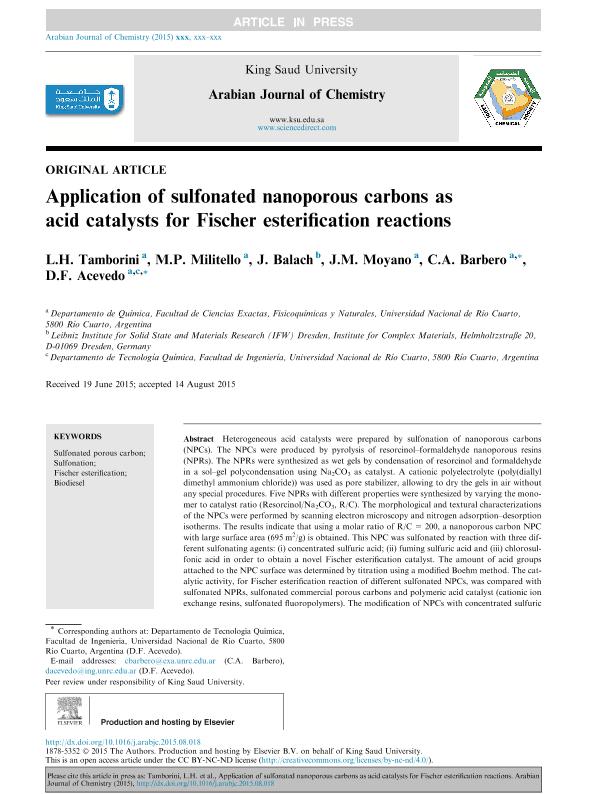Mostrar el registro sencillo del ítem
dc.contributor.author
Tamborini, Luciano Henri

dc.contributor.author
Militello, María Paula

dc.contributor.author
Balach, Juan Manuel

dc.contributor.author
Moyano, J. M.
dc.contributor.author
Barbero, César Alfredo

dc.contributor.author
Acevedo, Diego Fernando

dc.date.available
2019-02-12T17:30:19Z
dc.date.issued
2015-06
dc.identifier.citation
Tamborini, Luciano Henri; Militello, María Paula; Balach, Juan Manuel; Moyano, J. M.; Barbero, César Alfredo; et al.; Application of sulfonated nanoporous carbons as acid catalysts for Fischer esterification reactions; Elsevier; Arabian Journal of Chemistry; 6-2015; 1-11
dc.identifier.issn
1878-5352
dc.identifier.uri
http://hdl.handle.net/11336/69974
dc.description.abstract
Heterogeneous acid catalysts were prepared by sulfonation of nanoporous carbons (NPCs). The NPCs were produced by pyrolysis of resorcinol-formaldehyde nanoporous resins (NPRs). The NPRs were synthesized as wet gels by condensation of resorcinol and formaldehyde in a sol-gel polycondensation using Na2CO3 as catalyst. A cationic polyelectrolyte (poly(diallyl dimethyl ammonium chloride)) was used as pore stabilizer, allowing to dry the gels in air without any special procedures. Five NPRs with different properties were synthesized by varying the monomer to catalyst ratio (Resorcinol/Na2CO3, R/C). The morphological and textural characterizations of the NPCs were performed by scanning electron microscopy and nitrogen adsorption-desorption isotherms. The results indicate that using a molar ratio of R/C=200, a nanoporous carbon NPC with large surface area (695m2/g) is obtained. This NPC was sulfonated by reaction with three different sulfonating agents: (i) concentrated sulfuric acid; (ii) fuming sulfuric acid and (iii) chlorosulfonic acid in order to obtain a novel Fischer esterification catalyst. The amount of acid groups attached to the NPC surface was determined by titration using a modified Boehm method. The catalytic activity, for Fischer esterification reaction of different sulfonated NPCs, was compared with sulfonated NPRs, sulfonated commercial porous carbons and polymeric acid catalyst (cationic ion exchange resins, sulfonated fluoropolymers). The modification of NPCs with concentrated sulfuric acid seems to render the materials with more catalytic activity. The best sulfonated material NPC (PC200-H2SO4) shows a high catalytic activity for the esterification of acetic acid (90.8%) and oleic acid (60.6%) with ethanol. The conversion and conversion rate values are better than commercial acid catalysts. The results suggest that sulfonated NPC catalysts are promising materials for the synthesis of biodiesel and related reactions.
dc.format
application/pdf
dc.language.iso
eng
dc.publisher
Elsevier

dc.rights
info:eu-repo/semantics/openAccess
dc.rights.uri
https://creativecommons.org/licenses/by-nc-nd/2.5/ar/
dc.subject
Biodiesel
dc.subject
Fischer Esterification
dc.subject
Sulfonated Porous Carbon
dc.subject
Sulfonation
dc.subject.classification
Otras Ingeniería Química

dc.subject.classification
Ingeniería Química

dc.subject.classification
INGENIERÍAS Y TECNOLOGÍAS

dc.title
Application of sulfonated nanoporous carbons as acid catalysts for Fischer esterification reactions
dc.type
info:eu-repo/semantics/article
dc.type
info:ar-repo/semantics/artículo
dc.type
info:eu-repo/semantics/publishedVersion
dc.date.updated
2019-02-12T13:24:29Z
dc.journal.pagination
1-11
dc.journal.pais
Países Bajos

dc.journal.ciudad
Amsterdam
dc.description.fil
Fil: Tamborini, Luciano Henri. Universidad Nacional de Río Cuarto. Facultad de Ciencias Exactas Fisicoquímicas y Naturales. Departamento de Química; Argentina. Consejo Nacional de Investigaciones Científicas y Técnicas; Argentina
dc.description.fil
Fil: Militello, María Paula. Universidad Nacional de Río Cuarto. Facultad de Ciencias Exactas Fisicoquímicas y Naturales. Departamento de Química; Argentina. Consejo Nacional de Investigaciones Científicas y Técnicas; Argentina
dc.description.fil
Fil: Balach, Juan Manuel. Leibniz Institute for Solid State and Materials Research; Alemania. Consejo Nacional de Investigaciones Científicas y Técnicas; Argentina
dc.description.fil
Fil: Moyano, J. M.. Universidad Nacional de Rio Cuarto. Facultad de Ingeniería. Departamento de Tecnología Química; Argentina
dc.description.fil
Fil: Barbero, César Alfredo. Universidad Nacional de Río Cuarto. Facultad de Ciencias Exactas Fisicoquímicas y Naturales. Departamento de Química; Argentina. Consejo Nacional de Investigaciones Científicas y Técnicas; Argentina
dc.description.fil
Fil: Acevedo, Diego Fernando. Universidad Nacional de Río Cuarto. Facultad de Ciencias Exactas Fisicoquímicas y Naturales. Departamento de Química; Argentina. Universidad Nacional de Rio Cuarto. Facultad de Ingeniería. Departamento de Tecnología Química; Argentina. Consejo Nacional de Investigaciones Científicas y Técnicas; Argentina
dc.journal.title
Arabian Journal of Chemistry
dc.relation.alternativeid
info:eu-repo/semantics/altIdentifier/doi/http://dx.doi.org/10.1016/j.arabjc.2015.08.018
dc.relation.alternativeid
info:eu-repo/semantics/altIdentifier/url/https://www.sciencedirect.com/science/article/pii/S1878535215002580
Archivos asociados
